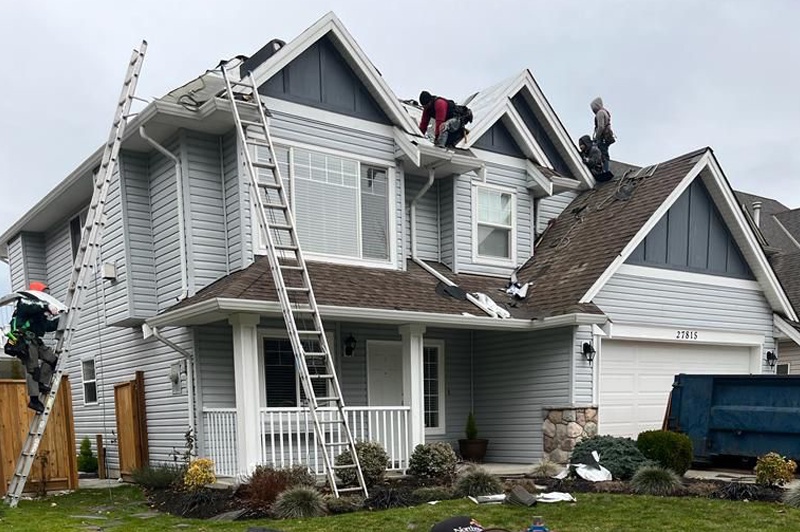Introduction:
Shingles roofs are a ubiquitous feature in residential architecture, offering both practical protection and aesthetic appeal. Comprised of overlapping elements, these roofs come in various materials, each with its own advantages and considerations. In this comprehensive guide, we'll delve into everything you need to know about shingles roofs, from the materials used to installation techniques and maintenance tips.
Understanding Shingles Roofs:
Shingles roofs are roofing systems composed of individual overlapping elements, known as shingles, laid in courses from the bottom edge of the roof up. These shingles provide a protective barrier against weather elements such as rain, snow, hail, and UV radiation. Shingles roofs are popular for their versatility, cost-effectiveness, and ease of installation compared to other roofing systems.
Types of Shingles Materials:
a. Asphalt Shingles:
- Asphalt shingles are the most common and economical choice for shingles roofs.
- They are made of a fiberglass mat or organic felt saturated with asphalt and coated with mineral granules for protection against UV rays.
- Asphalt shingles are available in various styles, including three-tab and architectural, offering versatility in design and affordability.
b. Wood Shingles and Shakes:
- Wood shingles and shakes provide a natural and rustic aesthetic to shingles roofs.
- Shingles are machine-cut from wood planks for a uniform appearance, while shakes are hand-split for a more textured look.
- Cedar, redwood, and pine are popular wood choices due to their durability and resistance to decay.
c. Metal Shingles:
- Metal shingles offer durability, longevity, and energy efficiency for shingles roofs.
- Made from materials such as steel, aluminum, or copper, metal shingles are lightweight and resistant to fire, rot, and insect damage.
- They come in various profiles and finishes, including traditional shingles, shakes, and tiles, offering versatility in design and customization.
d. Slate and Tile Shingles:
- Slate and tile shingles are premium options known for their durability and elegance.
- Slate shingles are made from natural stone, offering unparalleled longevity and resistance to fire and weathering.
- Tile shingles, including clay and concrete, provide a classic and timeless aesthetic to shingles roofs, with a range of colors, profiles, and textures available.
Installation Process:
a. Preparation:
- Proper preparation is crucial before installing shingles roofs, including removing old roofing materials, repairing any structural damage, and ensuring a clean and smooth substrate.
b. Underlayment:
- Install a waterproof underlayment, such as asphalt-saturated felt or synthetic membrane, to provide an additional layer of protection against moisture infiltration.
c. Shingle Installation:
- Begin laying shingles from the eaves upwards, overlapping each row to ensure proper water shedding.
- Follow manufacturer guidelines and local building codes for fastening methods, nail placement, and roof pitch requirements.
d. Flashing and Ventilation:
- Install flashing around roof penetrations, such as chimneys, vents, and skylights, to prevent water leaks.
- Ensure adequate ventilation to promote airflow and prevent moisture buildup in the attic space, which can lead to mold and rot.
Maintenance Tips:
a. Regular Inspections:
- Conduct visual inspections of your shingles roof at least twice a year, checking for signs of damage, wear, or debris buildup.
b. Cleaning:
- Remove debris, such as leaves, branches, and moss, from the roof surface to prevent water pooling and potential damage.
c. Repairs:
- Promptly repair any damaged or missing shingles to maintain the integrity of the roof and prevent water infiltration.
d. Professional Maintenance:
- Schedule periodic inspections and maintenance by a qualified roofing contractor to identify and address any issues before they escalate.
Conclusion:
Shingles roofs offer a practical and visually appealing solution for residential properties, with a variety of materials available to suit different preferences and budgets. Whether you opt for asphalt, wood, metal, slate, or tile shingles, proper installation and maintenance are essential for ensuring the longevity and performance of your roof. By understanding the materials, installation process, and maintenance requirements outlined in this guide, you can make informed decisions and enjoy a durable and attractive shingles roof for years to come.


No comments yet